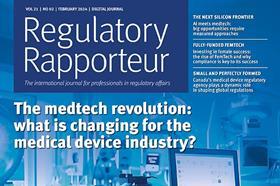

Regulatory Rapporteur
February 2024 | Volume 21 | No.2
In this edition of Regulatory Rapporteur, we embark on an exploration of the nuanced regulatory landscapes shaping the future of healthcare, medical devices and diagnostics, digital health and pharmaceuticals.
Our focus falls firstly on the transformative potential of integrating artificial intelligence (AI) and machine learning (ML) into Software as a Medical Device (SaMD), a development which is promising to revolutionise patient care.
However, existing regulatory frameworks in the US, the UK and the EU reveal gaps in addressing the unique challenges posed by AI/ML SaMD. In this context, a cohesive approach is essential to protect users, foster innovation and optimise the utility of this transformative technology. Noteworthy investment trends in Q1 of 2023 underscore the growing market share for AI-enabled devices, emphasising the need for proactive regulatory guidance.
Beyond patient care, the transformative potential of AI in healthcare extends to streamlining administrative tasks, reducing costs and enhancing overall system efficiency. Yet, the delicate balance between the benefits and challenges of AI adoption is crucial for maintaining patient trust, privacy and safety. Governments and developers navigate diverse regulatory approaches, emphasising responsible development and testing in supportive jurisdictions while acknowledging unknown risks.

Shifting our focus to the EU Medical Device Regulation (MDR) transition, this issue also delves into the impact of the extended transition period and the implications of Regulation (EU) 2023/607 for manufacturers. With the extension to 2028 for legacy devices, manufacturers are tasked with crafting well-defined implementation plans, ensuring regulatory compliance and enabling the continued supply of safe devices to the EU market.
This conversation continues to evolve with the proposal put forward by the European Commission in January to further extend the transition period for the In Vitro Diagnostics Regulation (IVDR), allow the phased roll-out of the European Database on Medical Devices (EUDAMED) and add new obligations to manufacturers on supply.
Amid the EU MDR implementation, collaboration among regulators, manufacturers and stakeholders is crucial to adapt to the evolving regulatory landscape. The challenge of balancing stringent regulations with innovation highlights the need for ongoing cooperation to establish a robust, transparent and sustainable regulatory framework which prioritises patient safety and supports innovation.
A similarly proactive approach is proposed in our next article which highlights the pivotal role of chemical characterisation in ensuring the biological safety of medical devices during the development phase. Outlined in ISO 10993-18, this systematic process enables manufacturers to select safe materials, comply with regulations and reduce the need for extensive biocompatibility testing, all of which contribute to significant time and cost savings.
We also look to the future and introduce some readers to the term ‘FemTech’, which refers to products, services, medical devices, diagnostics and software that support the health of women or people assumed as female at birth (herein referred to as women or female). This article sheds light on the broad scope, the anticipated impact of this market and the importance of compliance with wider device regulations.
We also spotlight Canada’s proactive role in shaping global medical device regulations. Health Canada’s dynamic approach, collaboration with international agencies and adherence to global best practices underscore its commitment to inclusiveness, innovation and patient safety in the ever-evolving regulatory environment.
Finally, we turn our attention to pharmaceuticals where China’s dynamic landscape of regulation takes centre stage. It is essential for manufacturers seeking market entry to understand the intricacies of drug master file (DMF) filing. This issue provides a detailed exploration of China’s regulatory framework, recent reforms and the requirements associated with DMF filing, empowering manufacturers and regulators to navigate this complex process effectively.
Join us in delving into the forefront of healthcare innovation and regulation in this comprehensive exploration of the crucial issues shaping the industry’s future.
































No comments yet